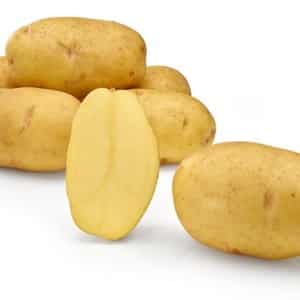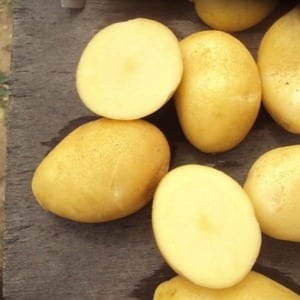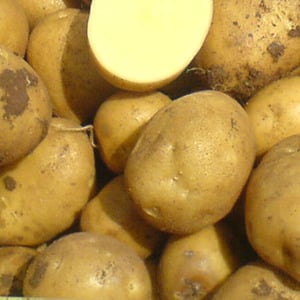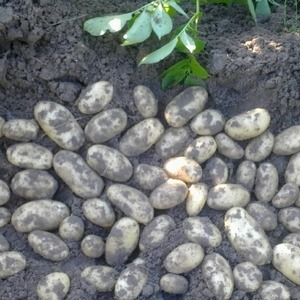Mid-early resistant potato variety “Satina”, which does not require special efforts when growing
Work on creating the Satin potato variety lasted several years. German breeders spent a lot of effort to obtain a crop that could quickly adapt to different climates and soils. However, the result even exceeded the expectations of the originator. Tests confirmed the declared characteristics of the crop, and the excellent taste made the variety popular everywhere.
Today Satin is grown not only in the West, but also in Russia, Belarus and Ukraine. Potatoes are not picky in care and show high yields in any region. It is grown not only for personal farming, but also on an industrial scale for sale.
Description of the Satin potato variety
 The Satin potato variety has the following characteristics: high resistance to any climatic conditions and rich yield. As a result, potatoes became widespread in the CIS countries. Belongs to the table type.
The Satin potato variety has the following characteristics: high resistance to any climatic conditions and rich yield. As a result, potatoes became widespread in the CIS countries. Belongs to the table type.
The bush is powerful, spreading moderately, the foliage is rich green. When flowering, neat corollas with white-cream flowers are formed. The root system is well developed.
Ripening dates are mid-early, full maturity occurs in 65-80 days.
Culture has increased resistance to drought and many diseases the nightshade family, such as scab, rhizoctonia, leafroll virus and blue spot disease. With timely implementation of preventive measures, it exhibits resistance to late blight.
What is the difference from other varieties
The main difference between Satina and others is its high fruiting rate and resistance to prolonged drought. Also gardeners celebrate simple agricultural techniques, which even a beginner can handle. Vegetables are resistant to mechanical damage, making them suitable for long-term transportation.
Chemical composition, trace elements and vitamins
Tubers contain dozens of vitamins and minerals: vitamin C (ascorbic acid), B vitamins, in particular B5 (nicotinic acid) and B9 (folic acid), potassium salts and phosphorus, citric and oxalic acids and others.
Reference! By consuming 200-300 g of potatoes, you can fill the body’s daily need for vitamin C.
Characteristics of tubers
 The average weight of tubers is 90-130 g, oval shape, slightly elongated, the peel is strong, light yellow in color. The pulp is yellow and may darken slightly when cooked. The taste is high, ripe vegetables are moderately sweet and low in starch. The proportion of starch does not exceed 15%.
The average weight of tubers is 90-130 g, oval shape, slightly elongated, the peel is strong, light yellow in color. The pulp is yellow and may darken slightly when cooked. The taste is high, ripe vegetables are moderately sweet and low in starch. The proportion of starch does not exceed 15%.
The fruits are used universally in all food industries. Ripe vegetables are in stable demand in markets; they are purchased not only by retail consumers, but also by large enterprises for further processing to make chips and fast food products. Potatoes are in demand in the restaurant business and in the catering industry.
Productivity
The varietal characteristics of Satina complement the fruiting indicators. Up to 420 centners are harvested from 1 hectare if proper care is provided during the growing season. The crop is able to take root and bear fruit in soil of any composition and in any climatic zone.
The yield of finished products is 85-90% of the harvest.A high percentage of shelf life (95-97%) complements the list of advantages.
Reference. One seedling produces from 8 to 12 potatoes. All tubers are aligned, the same size, there are practically no small or curved ones.
Growing regions
For Satina there are no restrictions regarding soil composition and climatic conditions. The culture will take root well in all farming zones. For this reason, the variety is in enviable demand among entrepreneurs. German potatoes have taken root in Russia, Belarus, Ukraine, and are widely known in the Republic of Moldova.
About other potato varieties:
Landing dates
Sowing is carried out depending on the climatic characteristics of the region. Usually this is the end of April - the first days of May, when the air temperature will remain at +16...+18°С, and the soil will warm up to +9...+11ºС.
When expecting return frosts, it is better to postpone planting. Also, do not rush to sow when there is a threat of heavy rains. To obtain healthy shoots seed material needs comfortable conditions.
Reference! Experienced gardeners focus on birch leaves when planting potatoes. As soon as the first leaves become noticeable, sowing begins.
Advantages and disadvantages of Satin
Let's sum it all up advantages of the variety:
 possibility of breeding in all regions;
possibility of breeding in all regions;- ease of care;
- drought resistance;
- high resistance;
- rich fruiting;
- excellent taste and presentation;
- long transportations;
- resistance to mechanical damage;
- storage duration;
- universal purpose of root vegetables.
Those gardeners who planted crops in their beds note a slight darkening of the pulp during cooking. The variety has no other disadvantages.
Features of planting and growing
Satina grows and bears fruit in any climate and any soil.. However, light and fertile soil is preferable for all potato varieties. It is in such soil that seedlings will grow faster, become stronger and produce a rich harvest. In heavy clay soil, the fruiting rate is reduced to a minimum.
Pre-sowing preparation
 After winter storage, the tubers are carefully inspected for darkening and damage. Potatoes the size of a chicken egg and weighing no more than 100 g are selected for sowing.. After careful inspection, they are laid out in a bright room for germination. Only sprouted tubers with a sprout length of at least 2 cm are planted.
After winter storage, the tubers are carefully inspected for darkening and damage. Potatoes the size of a chicken egg and weighing no more than 100 g are selected for sowing.. After careful inspection, they are laid out in a bright room for germination. Only sprouted tubers with a sprout length of at least 2 cm are planted.
Directly Before planting, potatoes are treated with a growth stimulator, for example, “Epin”, “Bioglobin”. Growth stimulants strengthen plant immunity and accelerate the germination process. The seed material is also treated with Fitosporin for disinfection and protection against fungal infections.
Important! If there is insufficient light, the germinated sprouts will be thin and fragile, which will make the seed vulnerable and reduce the number of seedlings.
Planting scheme and technology
Planting scheme: 30-35 cm – distance between seedlings, 70 cm is left between rows.
The soil is dug up for the first time in the fall, introducing humus and wood ash. These components saturate the soil, increasing its fertility. They dig up the second time two weeks before planting and apply the same fertilizers.
Seed material is planted to a depth of 8-10 cm and sprinkle wood ash on top.
Further care for potatoes
After landing standard agricultural technology is used in plant care. To obtain a rich harvest, seedlings require moderate watering and systematic feeding.
Watering mode
 To reduce the risk of fungal diseases, avoid high humidity in the beds - watering should be moderate and not frequent. It is best to install a drip irrigation system, in which the water will go directly to the roots of the seedlings without creating excess moisture in the beds.
To reduce the risk of fungal diseases, avoid high humidity in the beds - watering should be moderate and not frequent. It is best to install a drip irrigation system, in which the water will go directly to the roots of the seedlings without creating excess moisture in the beds.
The crop needs abundant watering during the budding period and at the time of fruit formation. The rest of the time, in normal weather, water no more than once every two weeks.
After watering, the moistened soil is loosened for aeration.. Access of oxygen to the roots has a positive effect on the growth and development of seedlings.
Weed removal – an important procedure in caring for potatoes. Pathogenic microorganisms and many insects that harm seedlings live and multiply in weeds.
Mulching the beds prevents the growth of weeds and reduces moisture evaporation, so the beds remain wet longer. Dry leaves, peat, straw and dry sawdust are used as mulch.
When the seedlings reach 15 cm in height carry out the first hilling. This will protect the root crops from ground pests and direct sunlight. Hill up at least three times per season.
Reference! The hilling procedure involves raking the soil from the rows onto the plants.
Feeding
The first time the crop is fed 2-3 weeks after germination. Ammonium nitrate or nitrogenous substances are suitable as fertilizers. They will accelerate the growth of seedlings.
The seedlings are fertilized for the second time at the moment of flowering. Organic matter is used, for example, bird droppings or mullein infusion in a concentration of 1:10.With a stronger dilution, the solution can cause a burn to the root system.
The third feeding is carried out a week before fruiting. They add a full range of minerals, focusing on potassium and phosphorus.
Disease and pest control
Phytophthora is a fungal disease that quickly attacks plants.. The disease is especially active in rainy and warm weather. Prevention against late blight begins immediately after planting. The seedlings are sprayed with “Fitosporin”, thereby destroying fungal spores.
Preventive measures also include:
- moderate watering;
- systematic application of fertilizers;
- loosening and hilling;
- weeding beds;
- daily inspection of plantings.
 Diseased bushes are not left in the bedsso that the infection does not spread from them to healthy seedlings. Affected plants are burned, and the remaining plantings are treated with Fitosporin.
Diseased bushes are not left in the bedsso that the infection does not spread from them to healthy seedlings. Affected plants are burned, and the remaining plantings are treated with Fitosporin.
When affected by nematodes, the storage period of potatoes is significantly reduced.. Nematodes are parasitic worms that attack the root system. Deep digging of the soil destroys adults and larvae. Marigolds also have a negative effect on worms. These flowers are planted between potato seedlings, thereby protecting the future harvest.
The drug “Prestige” is used against the Colorado potato beetle. Its larvae, living on the undersides of leaves, are no less dangerous than adult insects. Therefore, when inspecting seedlings, it is important to turn over the leaves so as not to miss the pest. The plants are inspected every day, as the beetles multiply quickly and destroy the plantation.
Read also:
Potato Galaxy with long shelf life
Harvest and storage
 A few days before harvest They mow down and then burn the potato tops - they cannot be left, as pests and fungal spores remain in them.
A few days before harvest They mow down and then burn the potato tops - they cannot be left, as pests and fungal spores remain in them.
The fruits are dug up with a pitchfork or shovel, after which left on the area to dry. In strong sun conditions, provide a canopy to protect the potatoes from scorching.
After drying the tubers carefully inspected and placed in wooden boxes for further storage. The room where boxes of potatoes are left should be cool and dry.
They are transported in the same boxes. They are transported to any distance with full preservation of presentation.
Difficulties encountered during cultivation
With proper soil distribution, soil fertility is maintained, which means crop productivity increases. These are called crop rotation rules. Thanks to the correct rotation of plants The fertility of the land can be maintained even in a small area.
 Potato planted in those beds where legumes, winter crops, carrots or cabbage previously grew. After legumes and winter crops, the soil is saturated with nitrogen.
Potato planted in those beds where legumes, winter crops, carrots or cabbage previously grew. After legumes and winter crops, the soil is saturated with nitrogen.
Potatoes should not be planted after peppers, tomatoes and eggplants. There will be no rich harvest due to depleted soil.
Onions and carrots are considered good neighbors for potatoes. Cultures do not suffer from the same diseases and do not prevent each other from developing.
If you plant dill between potato bushes, you can attract ladybugs to your beds. It eats many pests that attack potato seedlings, such as aphids.
Advice from vegetable growers
Experienced vegetable growers are happy to share observations and tips for growing potatoes:
- To protect the seed from fungus, before planting, spray the tubers with a weak solution of potassium permanganate from a spray bottle. Solution dosage: 2 g per 10 liters of water. You can also sprinkle the potatoes with wood ash.
- If large tubers were cut before planting, there is no need to sprinkle them with ash. It is better to pour it into the hole and place the tuber cut side up.
Farmer reviews
 Gardeners leave positive reviews about the variety. This is not surprising, because culture has a lot of advantages:
Gardeners leave positive reviews about the variety. This is not surprising, because culture has a lot of advantages:
Emelyan, Astrakhan: “I planted the Satina potato variety for the first year. I bought the seed from a friend. I liked this crop because it is easy to care for and the harvest is very rich. The supply was enough for the whole winter, although I planted very little. The first and second courses were made from vegetables. They also made delicious New Year’s salads.”.
Semyon, Dnepropetrovsk: “I grow mainly for sale. I plant different varieties. Satin is liked for its unpretentiousness and high yield. Potatoes, of course, are delicious, so they sell out quickly in the markets. You can cook all kinds of dishes from it; vegetables retain their taste everywhere.”.
Conclusion
Satina potatoes have successfully taken root in the Russian climate, for which they have received recognition from vegetable growers throughout the country. The crop practically does not get sick, is easy to care for and produces rich harvests.
The high percentage of shelf life allows the variety to be grown in large volumes for further sale. Almost the entire harvest is stored until spring without losing its marketable value.